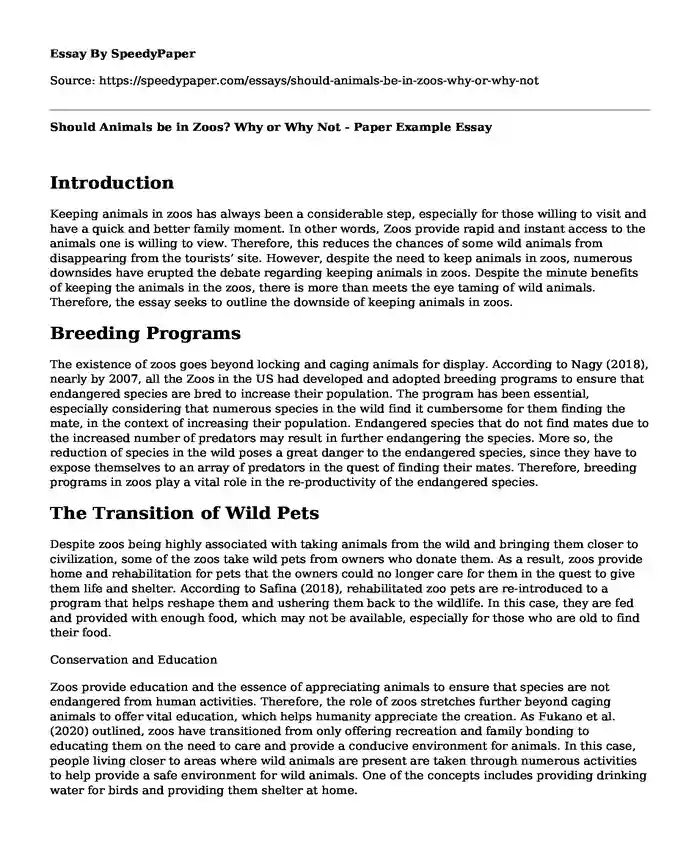Introduction
Keeping animals in zoos has always been a considerable step, especially for those willing to visit and have a quick and better family moment. In other words, Zoos provide rapid and instant access to the animals one is willing to view. Therefore, this reduces the chances of some wild animals from disappearing from the tourists’ site. However, despite the need to keep animals in zoos, numerous downsides have erupted the debate regarding keeping animals in zoos. Despite the minute benefits of keeping the animals in the zoos, there is more than meets the eye taming of wild animals. Therefore, the essay seeks to outline the downside of keeping animals in zoos.
Breeding Programs
The existence of zoos goes beyond locking and caging animals for display. According to Nagy (2018), nearly by 2007, all the Zoos in the US had developed and adopted breeding programs to ensure that endangered species are bred to increase their population. The program has been essential, especially considering that numerous species in the wild find it cumbersome for them finding the mate, in the context of increasing their population. Endangered species that do not find mates due to the increased number of predators may result in further endangering the species. More so, the reduction of species in the wild poses a great danger to the endangered species, since they have to expose themselves to an array of predators in the quest of finding their mates. Therefore, breeding programs in zoos play a vital role in the re-productivity of the endangered species.
The Transition of Wild Pets
Despite zoos being highly associated with taking animals from the wild and bringing them closer to civilization, some of the zoos take wild pets from owners who donate them. As a result, zoos provide home and rehabilitation for pets that the owners could no longer care for them in the quest to give them life and shelter. According to Safina (2018), rehabilitated zoo pets are re-introduced to a program that helps reshape them and ushering them back to the wildlife. In this case, they are fed and provided with enough food, which may not be available, especially for those who are old to find their food.
Conservation and Education
Zoos provide education and the essence of appreciating animals to ensure that species are not endangered from human activities. Therefore, the role of zoos stretches further beyond caging animals to offer vital education, which helps humanity appreciate the creation. As Fukano et al. (2020) outlined, zoos have transitioned from only offering recreation and family bonding to educating them on the need to care and provide a conducive environment for animals. In this case, people living closer to areas where wild animals are present are taken through numerous activities to help provide a safe environment for wild animals. One of the concepts includes providing drinking water for birds and providing them shelter at home.
Counter Argument
There is a much darker side when it comes to inhuman activities performed by humans in the quest to keep the animals in zoos, as animals in captivity are deprived of their right to roam freely and explore the nature. Capturing and confining animals into cages or a limited environment depicts a modern slavery concept, which deprives the animals, rights to choose their families freely. Moreover, some of the animals brought into the zoos are separated from their biological families. However, since they are animals, consideration of their feeling is not put into account, making them suffer psychologically.
On the contrary, intergenerational bonds are broken when animals are sold or traded to other zoos, which affects the traded animal. The breeding program leads to overpopulation, which leads to the selling of surplus animals (Safina, 2018). The sold animals may be subjected to circuses, or even into canned hunting facilities, a step that highly betrays the trust zoos have built.
Conclusion
The keeping animals in zoos has widely violated the rights of the animals, despite most of the individuals arguing that zoos provide shelter and protection. Breading programs lead to the over reproduction, which is geared towards generating income for the zoos. On the contrary, caging animals in a unified environment leads to boredom, which affects the animals in general. Despite the positive side of the zoos, in helping animals, there is a dark side in violation of animals’ rights, especially those separated from their families.
References
Fukano, Y., Tanaka, Y., & Soga, M. (2020). Zoos and animated animals increase public interest in and support for threatened animals. Science of The Total Environment, 704, 135352.doi.10.1016/j.scitotenv.2019.135352
Nagy, K. (2018). Food requirements of wild animals: Predictive equations for free-living mammals, reptiles, and birds.https://escholarship.org/uc/item/18s7d943
Safina, C. (2018). Where Are Zoos Going—or Are They Gone?. Journal of Applied Animal Welfare Science, 21(sup1), 4-11.doi.org/10.1080/10888705.2018.1515015
Cite this page
Should Animals be in Zoos? Why or Why Not - Paper Example. (2023, Dec 27). Retrieved from https://speedypaper.com/essays/should-animals-be-in-zoos-why-or-why-not
Request Removal
If you are the original author of this essay and no longer wish to have it published on the SpeedyPaper website, please click below to request its removal:
- Free Essay Example about Zoos and Their Role
- Free Essay: Using Bee Colony for Solving Traveling Salesman Problems TSP
- Free Essay - the Rio Grande River
- Free Essay: Contemporary Environmental Issue
- Forever Chemicals in New Jersey. Paper Example
- Free Essay. Distant Suffering' of Others Produce a Sense of Compassion
- Essay Example: Homeland Security Response and Recovery Assignment
Popular categories





